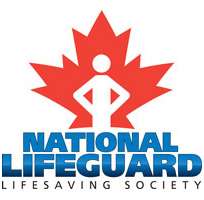National Lifeguard
| National Lifeguard | |
|---|---|
 National Lifeguard Logo | |
| Awarded for | Candidates who successfully complete the Nation Lifeguard program. |
| Sponsored by | Lifesaving Society |
| Country | Canada |
| Reward(s) | Certificate |
| First awarded | 1964 |
| Website |
www |
National Lifeguard (commonly referred to by its original name, National Lifeguard Service or NLS) is "the standard measure of lifeguard performance in Canada".[1] All lifeguards and assistant lifeguards are certified by the Royal Lifesaving Society of Canada. [2]
National Lifeguard certification builds on the fundamental skills, knowledge and values of the Lifesaving Society to develop the practical skills and knowledge required by lifeguards. National Lifeguard education is designed to develop a sound understanding of lifeguarding principles, good judgment and a mature and responsible attitude toward the role of the lifeguard.
The primary role of the National Lifeguard is the prevention of emergency situations and where this fails, the timely and effective resolution of emergencies. The National Lifeguard program is designed to prepare lifeguards to fulfill this role as professional facilitators of safe, enjoyable aquatics.
Industry standard
National Lifeguard was officially launched in 1964 in response to a need identified by employers for a single, recognized lifeguard certification for those charged with the responsibility of supervising pools and waterfronts. In 1973, the Lifesaving Society Canada, one of the National Lifeguard founding members, assumed responsibility for National Lifeguard which today is the industry-accepted standard for lifeguards in Canada. National Lifeguard is endorsed and supported by the National Lifeguard Advisory Committee composed of lifeguard employers, facility operators and national agencies: Canadian Parks and Recreation Association, Physical and Health Education Canada, YMCA and Canadian Forces. National Lifeguard is the only Canadian lifeguard standard recognized by the International Life Saving Federation and the Commonwealth Royal Life Saving Society.
Training
The National Lifeguard course (minimum 40 hours) cannot in theory or practice prepare candidates for every situation which might be encountered by National Lifeguards working in Canadian aquatic environments and facilities. National Lifeguard training is designed to develop the basic lifeguarding skills, principles and decision-making processes which will assist the lifeguard to evaluate and adapt to different aquatic facilities and emergencies. The National Lifeguard certification is available in four options – Pool, Waterpark, Waterfront and Surf.[3] Prerequisite: Minimum 16 years of age, Lifesaving Society Bronze Cross certification, and Standard First Aid certification.[4] National Lifeguard Pool certification is a prerequisite to National Lifeguard Waterpark. National Lifeguard Waterfront certification is a prerequisite to National Lifeguard Surf.
References
- ↑ "A Century of Saving Lives". 2005. Retrieved June 7, 2008..
- ↑ "Lifesaving Society Chronological Timelines". 2005. Retrieved June 7, 2008.
- ↑ "Lifesaving Society | NLS Award Guide - At-a-glance". www.lifesavingsociety.com. Retrieved 25 January 2016.
- ↑ "Lifesaving Society | National Lifeguard - Pool". www.lifesavingsociety.com. Retrieved 25 January 2016.
